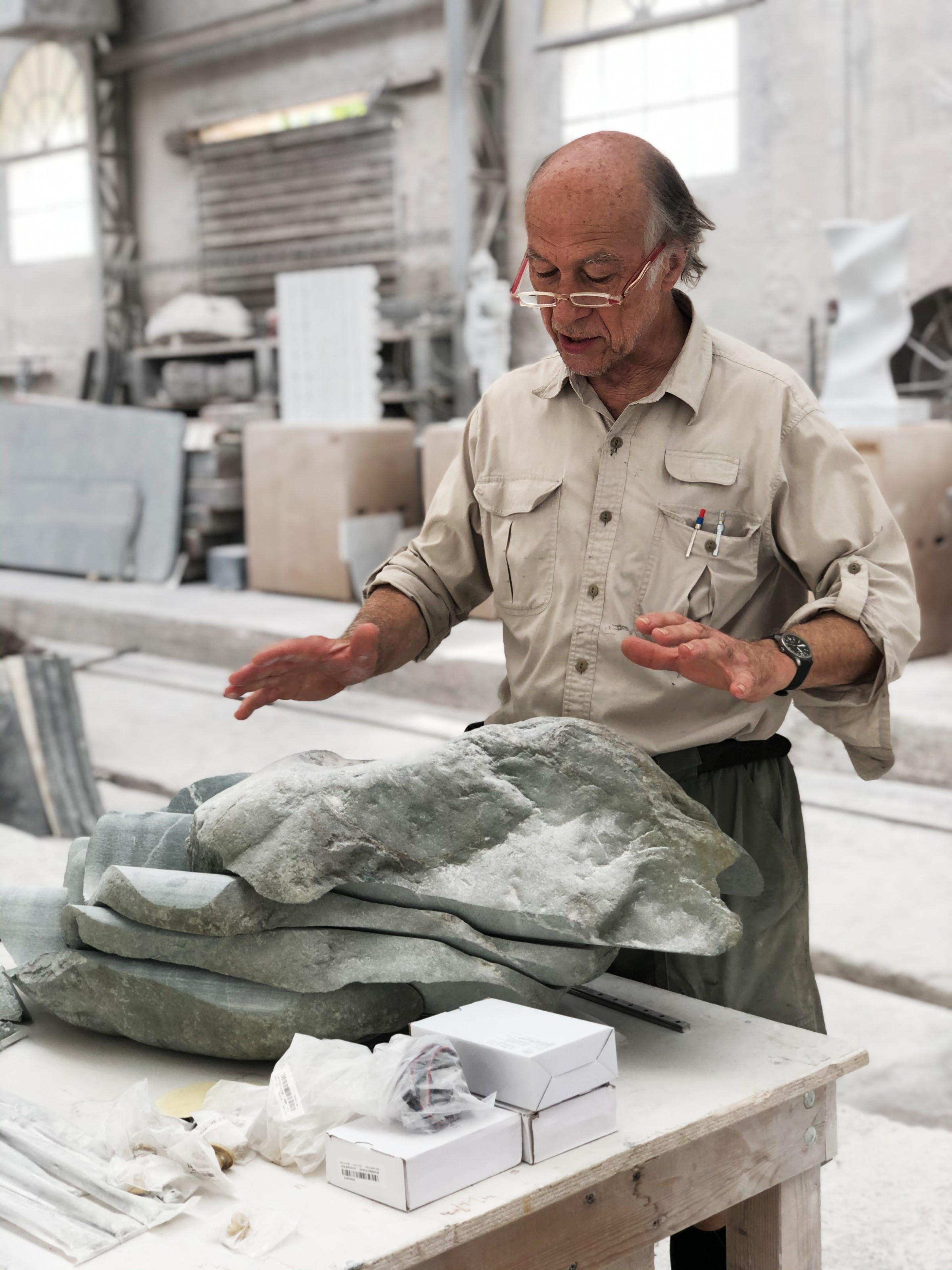
Nicolas Bertoux, LIVINGSTONE, 2020, in his workshop in Seravezza
Originally from Paris, Nicolas first came to Carrara with his father, also a sculptor, who was working on a monumental piece at Henraux.
Now he lives and works in Seravezza, northern Tuscany with his partner Cynthia Sah, in an extraordinary pre-industrial building which was once an historic sawmill, where marble was cut for the very first time by water-powered machinery.

Nicolas Bertoux examines a piece of marble in the light, Seravezza
He was drawn to move to the area not because of the studios and artisans, but because of the quarries. He likens the search for raw material to buying your food at a farm instead of a supermarket. He wants to talk to the quarrymen and know the chain of production.
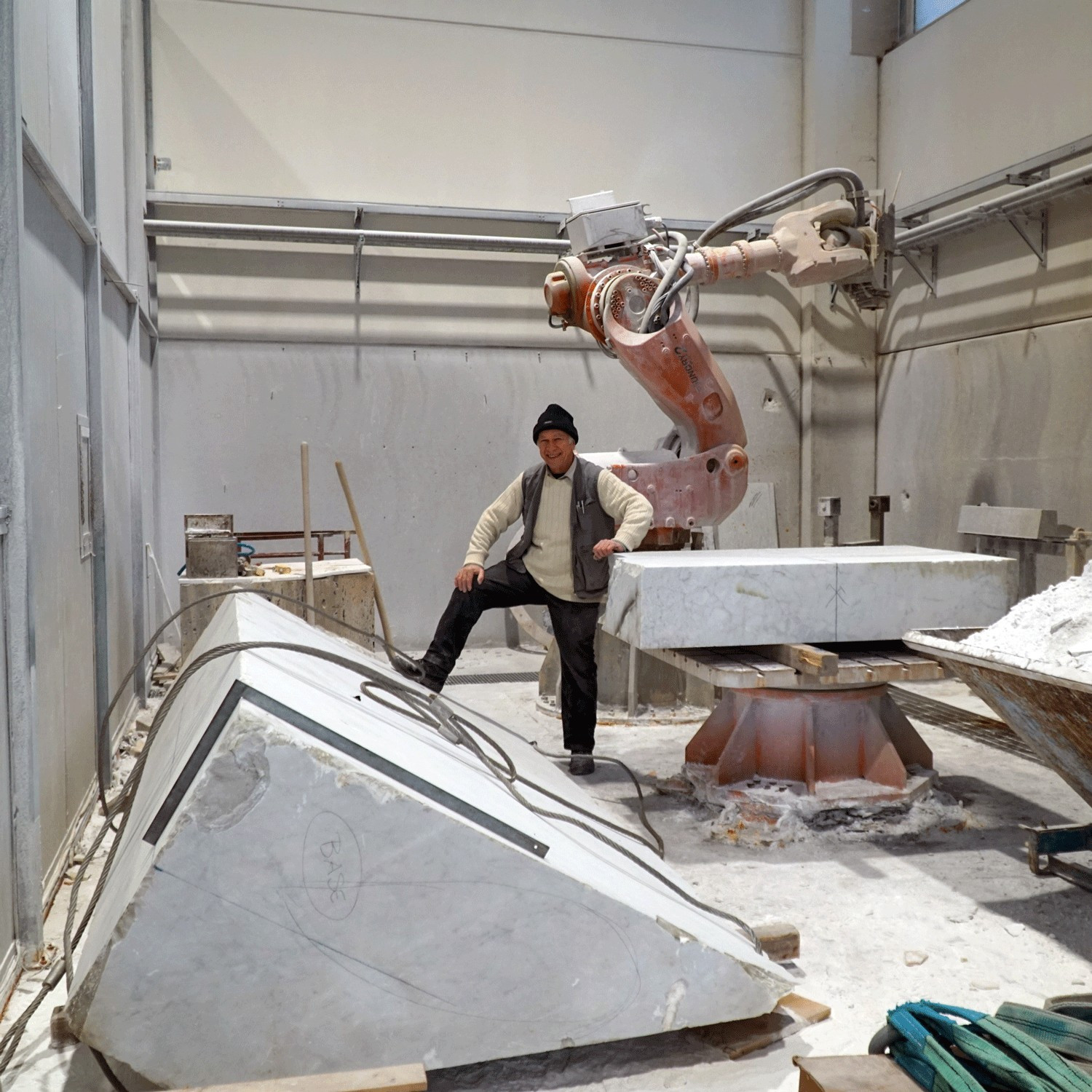
Nicolas Bertoux at La Fenice workshops, Pietrasanta, for his project Wind Tree, 2019, monumental sculpture for Taipei, Taiwan
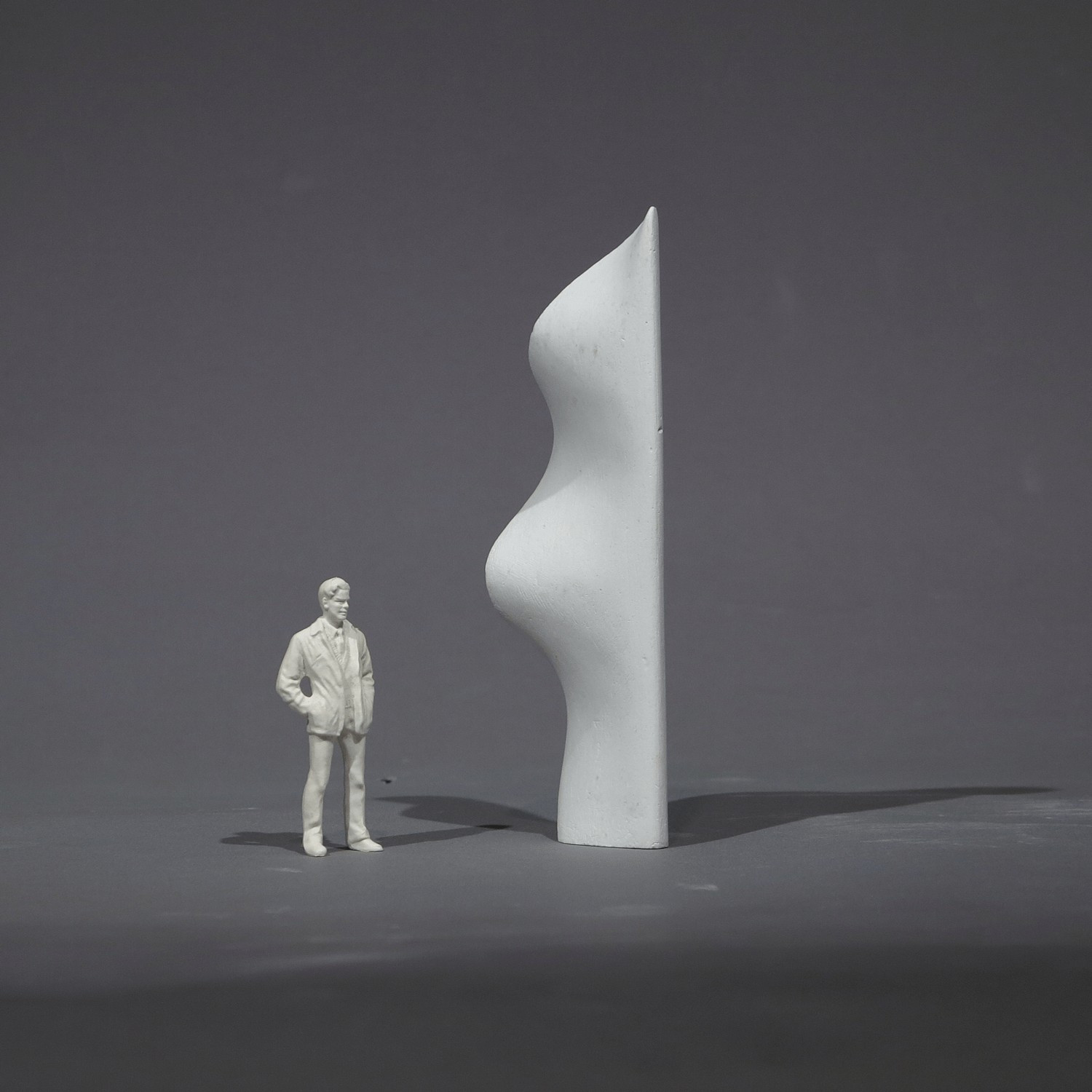
Model of Wind Tree project
The Wind Tree project was due to be installed just as the pandemic hit so instead of installing the piece himself Nicolas had to box it very carefully, then guide people at the other end to erect it in his absence.
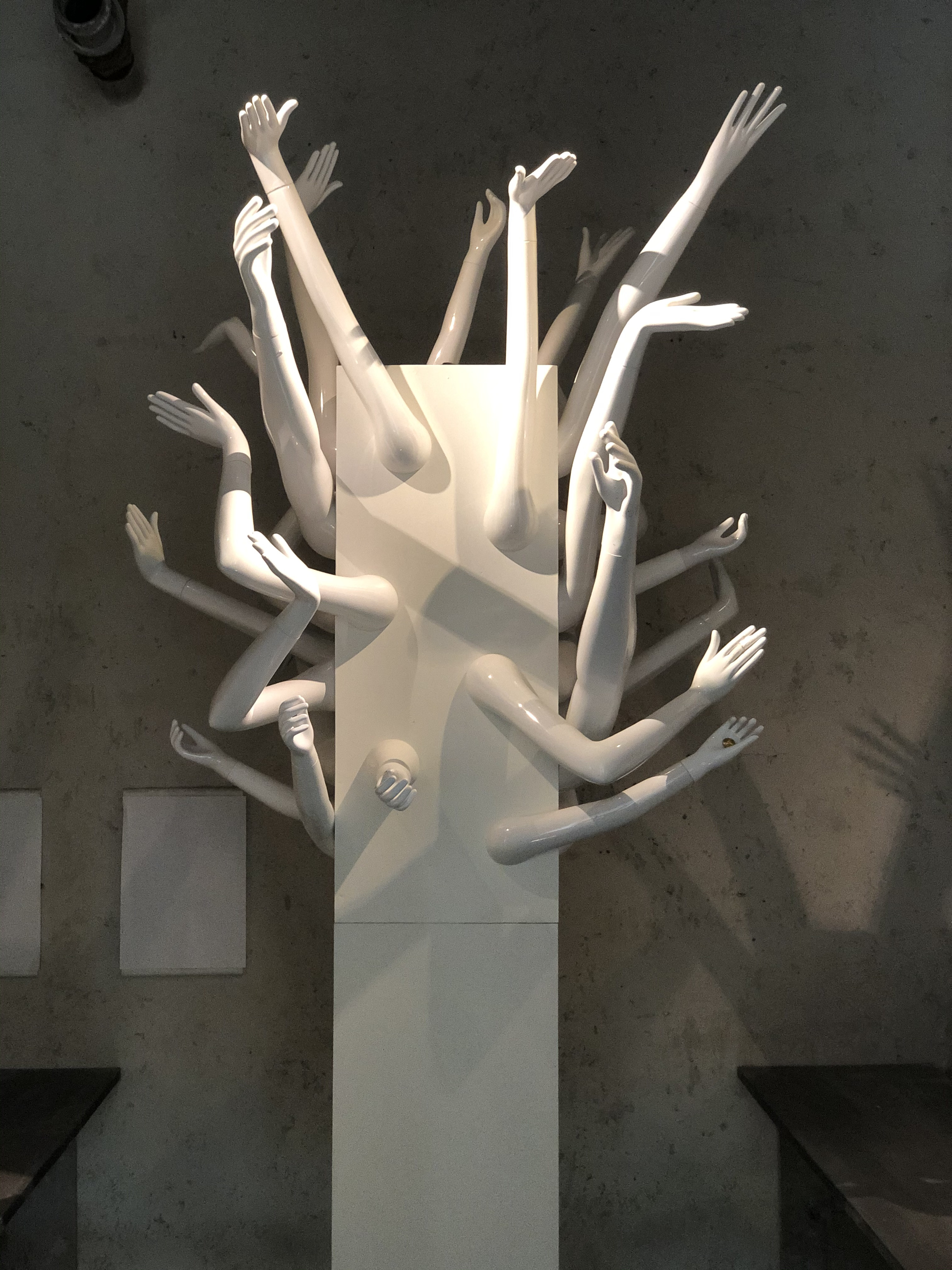
Nicolas Bertoux, Protesta (Yell), 2020
When Nicolas was approached by the coastguard, and forced to pay an administrative fine for a lack of paperwork, he and other sculptors created a work of protest – Protesta (Yell).
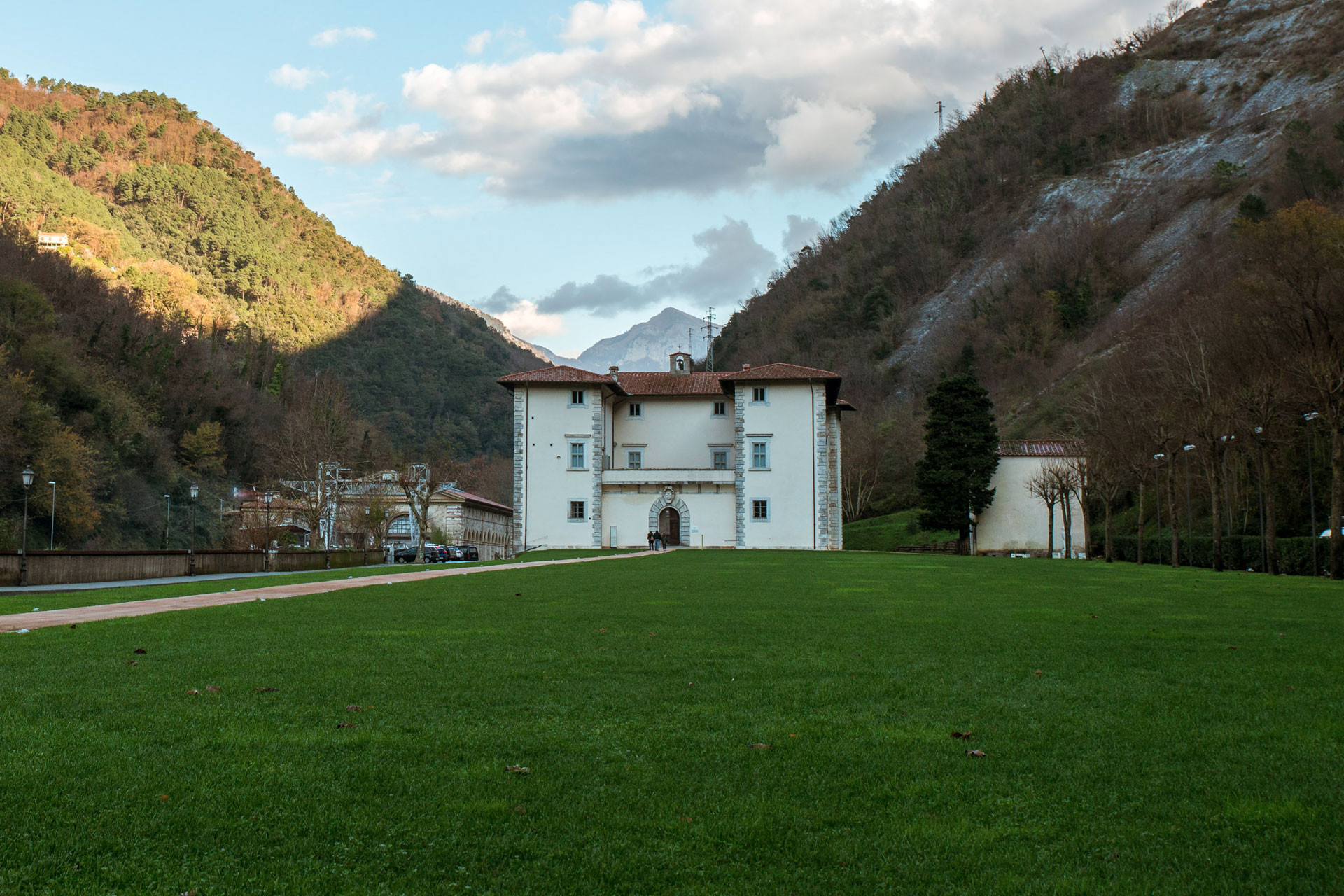
The Medici Palace of Seravezza, a Unesco World Heritage Site
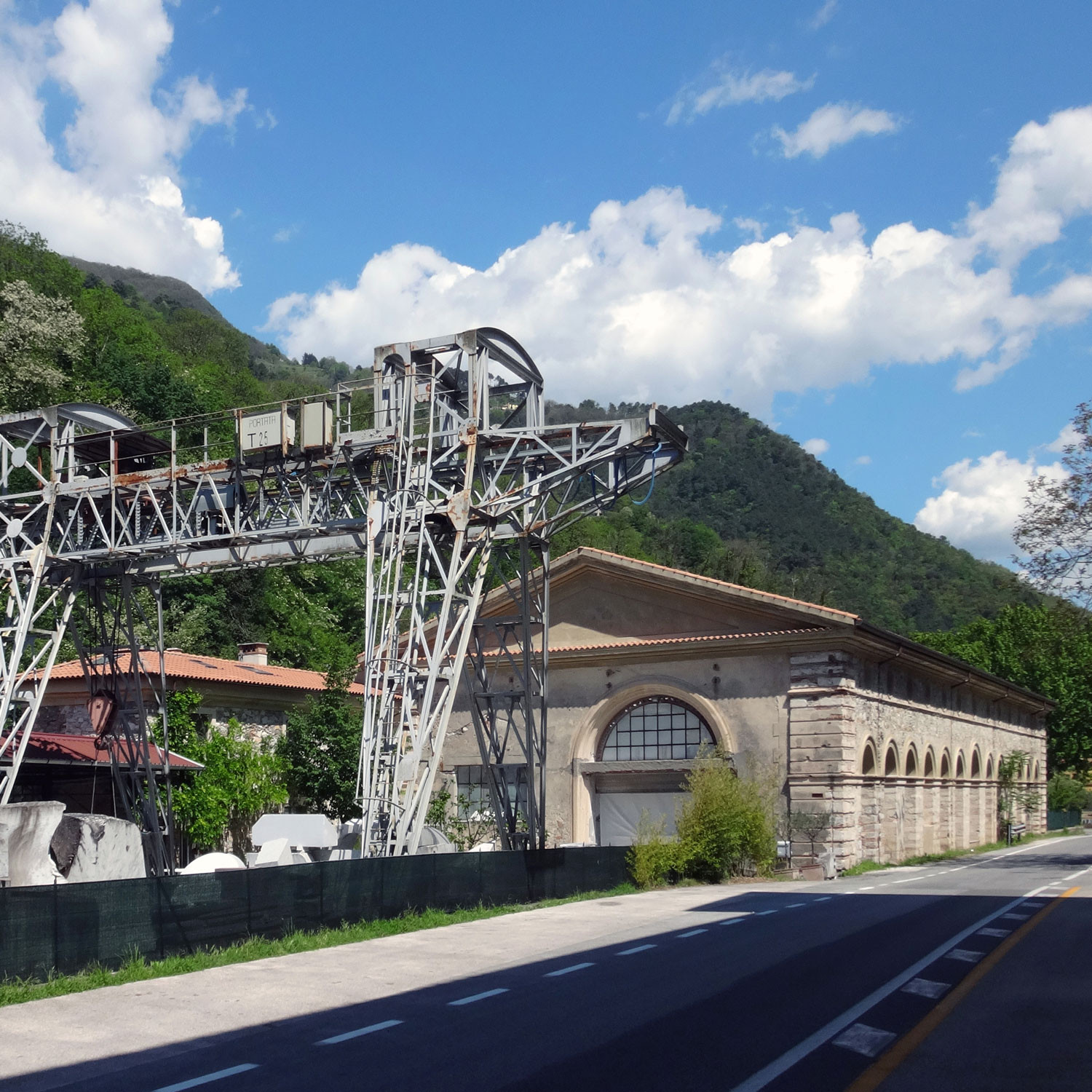
Cynthia and Nicolas' Artco workshops
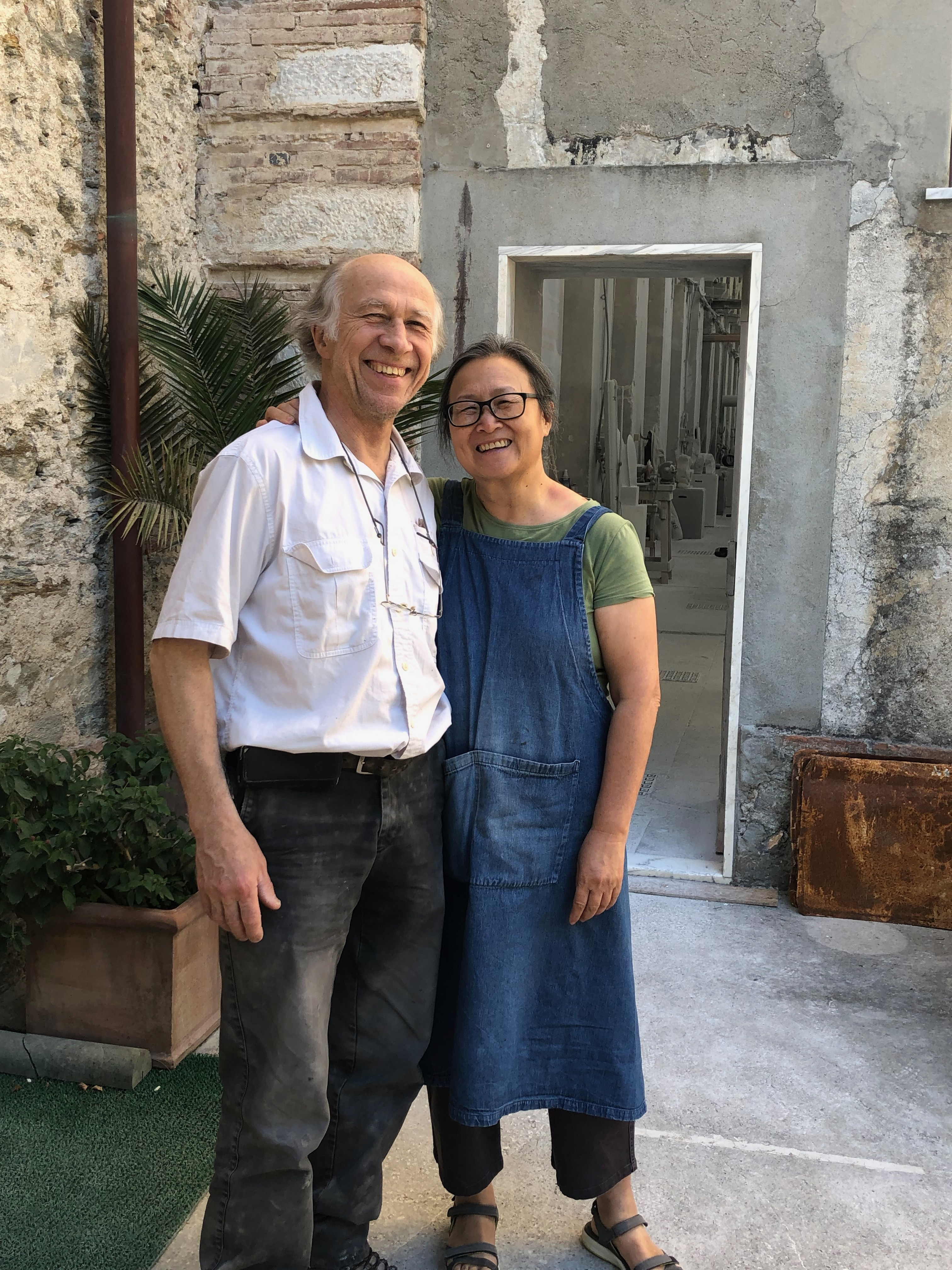
Nicolas Bertoux and Cynthia Sah, outside their workshops, Seravezza
Links
Find more about the Arkad Foundation
In the episode, Nicolas refers to:
The Italian sculptor Pietro Cascella, who created a memorial for the Auschwitz-Birkenau concentration and extermination camp which consists of blocks and columns on the site of the camp’s railway station. Pietro Cascella’s large work Memoria di Pietrasanta, 2001, represents oxen who pulled the marble down from the quarries, and stands opposite the town hall in Pietrasanta.
Gigi Guadagnucci (link in Italian) who was born in Castagnetola (Massa) in 1915, worked in marble from a very young age and distinguished himself by his ability to create funeral works without the use of models.
Credits
Producer: Sarah Monk
Sound edit/design: Guy Dowsett
Music: courtesy of Audio Network
Time Weaver 2298/6, Dan Skinner, Adam Skinner
Blind Man's Bluff 2959/1, Sam Wedgwood
Scallop Waltz 2 2879/29, Paul Ressel
I like to make sculpture to put somewhere. My brain is more to architecture, but my hands are more to sculpture. I need to mix both. So I need to work in sculpture that I can think about what is the reason to put a sculpture in this place. I like to note that what I’m thinking is going to a certain place.
Nicolas Bertoux:And to share it with people and connect it to where the marble is coming from. When you work on marble, it’s a delicate stone. When we go to the quarry and we cut a piece of marble from the mountain, it’s like to cut a fruit. The marble has this freshness, which is absolutely incredible.
Sarah Monk:Hi, this is Sarah with another episode of Materially Speaking, where artists tell their stories through the materials they choose. Today we’re in Northern Italy, in Seravezza, a town between Pietrasanta and Carrara, and I’m meeting Nicolas Bertoux. I’m right opposite a palace built by Cosimo de Medici the first, Grand Duke of Tuscany in the 1560s, in an extraordinary building where Nicholas works with his partner Cynthia. He’ll tell us more about the building, but just to mention that at one point it was historic sawmill where marble was cut for the very first time by water powered machinery. Nowadays, the enormous building is a vibrant workspace using state of the art technology, where Cynthia and Nicolas produce monumental sculptures, either of their own design or created in collaboration with other workshops through their company ArtCo.
Sarah Monk:I met with Nicolas twice, most recently to see how his pandemic year had gone. But to my surprise, the upset to the world order had started earlier for him, as he juggled to install a show in Hong Kong during the riots.
Sarah Monk:How has this year been for you, Nicholas?
Nicolas Bertoux:We had an exhibition in Hong Kong in September, but it was in the middle of the protesting in Hong Kong.
Sarah Monk:Oh my goodness.
Nicolas Bertoux:So it was a very difficult moment because the space is central, but it’s a difficult space because there are windows all around, so you have to do some scenery to put sculpture in a place that make them visible. Important thing for me was to create a space. So to create a space without putting any other element than our sculpture, which are mostly in marble and the base that are mostly in wood, We decide to work with three elements. We have the sculptures. We have the bases, which are the crates of the sculpture. So it’s a nice material. It’s a crate wood. And to separate the sculpture, I make some screens in marble, but big, big screens in marble that were three meter long by almost two meter high. They were big element, curved element. So each sculpture could have a little alcove.
Sarah Monk:So they had their own little area.
Nicolas Bertoux:Each sculpture has its own area. I put also some experimentation piece. What were they? Carpet made in marble, sculpture that are rocking, like a rocking chair, people can touch them, people can move them, they can interfere with some of these pieces. And I put the black hole sculpture, which is a sculpture that is turning around.
Nicolas Bertoux:So people can interfere on the sculpture and moving, and often it’s a surprise for them. You’re not accustomed to, when you touch a sculpture, that it’s moving. So we have this kind of experimentation, and I did also some tables between sculpture and design and different elements. It was a big challenge because of the exhibition room on the third floor of a building. And these elements are three meter, and there is no lift that can bring them. So we had to bring from the road with a crane on the third floor terrace, and from the terrace to roll them to the exhibition place. So all this is only technical, but it’s feasible.
Nicolas Bertoux:The other problem, there was a protest. So we didn’t know what will happen this night because we have to install by night because all these cranes are not allowed to move during the day in Hong Kong. So you have to move the crane at a certain time.
Nicolas Bertoux:The crane has to move between midnight and 01:00. But we cannot install the crane before 02:00 because there are still buses running, so the crane will block the traffic for the buses, so we cannot install them before
Nicolas Bertoux:02:00. But it was a typhoon, and it was a red alert typhoon. And the authorities said they are not allowed to do any outside work before 04:30 in the morning. And you have to dismantle the crane at 06:30 in the morning because the bus have to pass again.
Nicolas Bertoux:So it was like a red donkey. I don’t know if you know this game. You have to push one here, push one there, turn back, and in one hour and a half to install all this with still heavy wind. Typhoon was passed, but there was still heavy rain and heavy wind. So it was challenging to have this hanging on in the sky by the crane to go to the third floor terrace, but each floor is five, six meters, so it’s already a building.
Nicolas Bertoux:But we managed to do that and we finally we installed it. But during the exhibition, they were protesting just down below the exhibition center. So it was a bit scary. And one day they were on the street below. We can see that all the protesters and the police and reporter of the protest came and they said, what is happening here?
Nicolas Bertoux:And we said, we have an exhibition. And he stayed and looked and took picture of our exhibition for hours. You know, he just came from the demonstration and the demonstration were finished. And he was so happy after the tension of the protesting and the hangs and the conflict between the police and the protesters. And he arrived in this space with a sculpture, with art. And so we become friends with this reporter. So we had very interesting surprise like this one. That makes the moment very, very positive.
Nicolas Bertoux:It’s an important year for me because my father died in September, so it was an important moment and it was a nice moment because he died very peacefully and happy and with a sense of humor. And so this was, for me, important moment, but interesting moment, and not sad at all. So the death of my father was a nice moment. The second moment was very bad.
Nicolas Bertoux:We had a visit from the coast guard in the studio, and they say, what are you doing here? What we have no boat. We don’t sell fish. And no. No. We are here to control the ambience, pollution. Oh, okay. So I say, oh, you’re doing a sculpture in marble?
Nicolas Bertoux:Say, yes. So you do dust. When we work and dry, we do dust. And when we work with the water machine, we make mud. So to make it short, they give us some fines, and and it was absolutely absolute because it’s only fines about administration. They didn’t give any fine because of pollution, but they gave a fine because we didn’t have some documents that nobody never told us that it was existing in more than twenty years that we’re here.
Nicolas Bertoux:And after that, we talked with the mayor, we talked with our lawyers, and we saw that you cannot defend yourself in Italy. Because even if we think that we are not guilty, well, it’s just a problem of information, so we cannot be guilty not to be informative. But the lawyer say you have to pay, and that’s it. It was very, very bad.
Nicolas Bertoux:So we say, oh, maybe we should change country. But the building is quite heavy to move. So so we say we have to find a a solution to stay here. But many, many artists were afraid and upset about this situation because coming here after twenty years that we are here to give us some fine because we don’t have any document. We cannot invent that we need this kind of document. So it was bad and sad situation.
Nicolas Bertoux:This is a sculpture dedicated to the coast guards. It’s a protest.
Sarah Monk:It was really the coast guard. Why the coast guard?
Nicolas Bertoux:Because they are in charge of the pollution of the sea, and the river are going to the sea. And so they are controlling all the companies that are close to the river. With many other artists, we say, oh, we have to make an exhibition of protesting sculpture against this attitude of the Coastguard, sculpture to protest. And I find these arms of mannequin in the garbage, and the garbage is connected to the Coastguard also because it can be a pollution. But I recycle the garbage.
Nicolas Bertoux:You call them mannequin in English?
Sarah Monk:Yes, yes, same word.
Nicolas Bertoux:So I find all these arms, there are 25 arms. It’s a bit like a tree, but it’s a yell, you know, it’s a protesting yell in a sculptural way. So I did this piece also and I quite like it.
Sarah Monk:So what about lockdown? Where were you at?
Nicolas Bertoux:We had the exhibition, we had the loss of my father and we had the visit of the Coastguard And then, like the the the the cherry on top, we have the lockdown, the COVID.
Nicolas Bertoux:So we were in China in November. We were in Beijing. I was taking part of a jury for a competition in sculpture in in Beijing. It was crazy jury.
Nicolas Bertoux:We had to select between almost 3,000 projects. And after that, we came back here, and then we had some other interesting moments here. And we had a wedding in our studio in December. And after that, we had to present a project to Wuhan because we we have some clients that have a big development in Wuhan. So in December, we work on this project for Wuhan, and we send the project early January. And almost the day the project arrived in Wuhan, it was a lockdown in Wuhan. This is a city where the pandemic started in China.
Nicolas Bertoux:So they stopped everything. Of course, they stopped the project. And maybe nobody even looked at the project because there was many other things to think about and they had to close the whole city.
Nicolas Bertoux:So that was our first taste of the lockdown. So we sent this project and at the moment where it arrived in Wuhan, Wuhan was blocked.
Nicolas Bertoux:My name is Nicolas Bertoux. I’m French and I’m born in Paris. And I say I will never leave Paris, and this is my town.
Nicolas Bertoux:Finally, I changed my mind. I started to work very young in architecture because one of my uncle was an architect. In the other hand, my grandfather was a painter. And to keep me quiet, he said, Why don’t you make a drawing? So he gave me the dictionary and pick a page and then make a drawing of this one.
Nicolas Bertoux:So I had these two directions from my family. My father was a sculptor, so he started to work in sculpture. And also, was quite interested on handwork and working with dirty things. So I had all this element in my my sword.
Nicolas Bertoux:Put all that together after school, I worked with a architect. And after several years, my father had a company in sculpture and mosaic and interior architecture. So we decided to build a company together.
Nicolas Bertoux:And we we did interior architecture, we did the design, we did the sculpture, mosaic, and all this kind of thing together. And to do some sculpture from some project, we came to Italy. We came to Querceta and worked in the Henraux company.
Nicolas Bertoux:So I did my first sculpture in Henraux company in 1973. But I came before in Henraux because in ‘66, my father was doing a big wall relief for a hospital in Paris, and he did it in Henraux. The way of making it was not the carving by hand, it was carved by machine. And that was connecting for me the architecture, so you can work in big size, technology like engineer and sculpture. So you have all this mixture of things.
Nicolas Bertoux:The Henraux company was at this time one of the biggest marble company in the world. And they have this connection between architectural work and sculpture. There are many, many artists working in Henraux. This is where I met Henry Moore, for example. Pietro Cascella was doing a big sculpture, and also the way that he used marble really interested me because he was using blocks of marble to make a sculpture.
Nicolas Bertoux:This is not the image of Michelangelo carving with a chisel and a hammer. You can use the material and put material together and that interests me. When I see all this possibility of mixing size, mixing material and put all that together to create, to invent some sculpture. So after a while, more and more, I worked in sculpture. I was mixing architecture because my brain is more to architecture, but my hands are more to sculpture.
Nicolas Bertoux:So I need to work in sculpture that I can think a bit as an architect. To think about the place where to put it, where should it be there, what is the reason to put a sculpture in this place, And the other part, how will I make it? What will be the process of making it? And how will I have to invent some forms and ideas to to put in? And so I put all that together.
Nicolas Bertoux:So I was coming and going more and more between France and Italy to do sculpture here. I had my studio in Paris. It was okay to do architecture, okay to do some small pieces, but for the big one, I need to come to Pietrasanta. I used to come very often here.
Nicolas Bertoux:When I came here, it was nice because I didn’t have to do office work. When I was here, it was almost 100% sculpture work, so I like to come here and I said, Oh, maybe I have to move to Italy. But it was a difficult decision because my life was in Paris and Paris for me was like a village that I knew quite well.
Nicolas Bertoux:Here for me it was a paradise not because of the studios but because of the quarry. The fact that we are in the material source. To be able to go in the quarry and choose where the material is coming, I like to know where my piece is going and I like to know where the marble is coming.
Nicolas Bertoux:I don’t like to buy the marble in the supermarket, but I like to buy it in a quarry to talk with the quarrymen, to know who had quarried it and where it’s coming from exactly in the mountain. It’s like people with food. You like to know the chain of the producer, will grow the animal and who will kill it and who will cook it and who will eat it. Know, it’s a full story. When you go to the mountain, live in the natural life, quite a wildlife.
Nicolas Bertoux:What I like in the marble, it’s a very spectacular material because many materials like granite, you dig in the soil. For the travertine, you dig in the soil. For many materials, you dig. For the clay, you dig. But for the marble, you climb in the mountain.
Nicolas Bertoux:The quarrymen are a bit like alpinistas. They’re working almost 1,000 meter high in the mountain. You have this geometrical and technical thing carving the mountain. And see the contrast between both for me is really spectacular. You have the contrast of the blue sky. You have the contrast of the wild mountain, the green, the brown. And in the middle of that, have the white cut.
Nicolas Bertoux:People say it’s the white blood of the mountain. The blood is alive, know. So cutting the mountain to extract the white blood of the mountain is to make the mountain alive also. If we don’t cut the mountain, we don’t know what is inside.
Nicolas Bertoux:This is a treasure that is hiding inside. It’s a spectacular place, and I really enjoy to go in this mountain. This is a very special connection with the mountain. When we say the quarry, in Carrara, you have a mountain and you have hundreds of quarry, so it’s completely different.
Nicolas Bertoux:Carrara is more like an industrial extraction of marble. Seravezza is more on the human scale. You know, there’s one mountain, one quarry, one group of people working. It’s not a mass production. We need to have a place where we can make big sculpture. We’ve been lucky to to find in Seravezza because here it’s it’s very human size, you know. One of the person that influenced me in sculpture is Gigi Guadagnucci. We became friends a long time ago, I like his way to find the delicacy inside the marble and the harmony. And so I really appreciate his work. Gigi introduced me to Peleranno company and family.
Nicolas Bertoux:And, like, they have Henraux and they had Peleranno a little smaller, but they were the two most important company here in around Pietratsanta . And they had many quarries, and they allowed me to to make a big sculpture in their in their factory. So we we become more and more close.
Nicolas Bertoux:And in 1996, there was a flood in the area. Many company closed at this time. It was a tragedy. The roads were destroyed, villages were destroyed, people were killed by the flood. It was a terrible, terrible moment. And at this time, I see this Peleranno company coming to cut some blocks in the factory where I working. Said, why why are you coming here to cut some blocks?
Nicolas Bertoux:Oh, we closed the the the factory. They are closed forever. Now we oh, but what will you do with the building? Because I knew this building. I said, what what will we do with the building?
Nicolas Bertoux:Oh, we will one, we will put it down to make some apartment. I said, The one in Seravezza, what are you doing with this building? Oh, this building? We don’t know. I said, Look, maybe I know what we can do with this building. So he said, Okay, these are the keys. You can go and you visit it.
Nicolas Bertoux:It’s like if we were discovering the pyramid in the Pharoa. We do it from outside, but not from inside. We visit every places and we took some pictures and some video.
Nicolas Bertoux:So it was very, very nice. It’s a marble cutting factory, but it looks from middle age. It looks much older than than it is. So we discovered that the building was built on three different periods of the construction. The first first construction of the building was the fishing ponds for the Medici Palace.
Nicolas Bertoux:They had a fish farm. They were growing carps and trouts. It was a hundred meter long pools. And so this was built by the Medici at the same time than the palace. It was from the sixteenth century, built in 1565.
Nicolas Bertoux:To do this fish farm, they had to make a dam. They had to make a canal to bring the water. And finally, when the Medici family was not in the existing anymore after it was belonging to the Lorraine duke, they decide to build an iron factory. So they used the foundation of the pool to build an iron factory. So everything was toward metal, not marble at this time.
Nicolas Bertoux:Napoleon started the interest of the industry because also England started industrial era at this time. France started. Germany started. America started. But Italy was a little kingdom. There was no no Italy at this time.
Nicolas Bertoux:After Napoleon fall, the industry started. So English people came, French people came too to run the marble business. Some English brought a a machine that they invented to cut the marble because at this time, the marble was cut by hand. They had big blades and sand.
Nicolas Bertoux:So these English people brought the machine into the iron factory, and it works. And so they dismount the metal factory, and they built this marble factory, which was the first place in the world where a piece of marble was cut by machine. So it’s a historical building because of the Medici. It’s a historical building because of the iron production, but it’s very, very historical because it’s the first place where they cut the marble by machine.
Nicolas Bertoux:When you look at the facade, it’s a bit like a temple. It’s perfectly geometrically designed with symmetrical axe. They have a bigger window on the center. They have a balcony on the river in the center of the building. So it has been projected to be not only industrial building, but to be a beautiful building.
Sarah Monk:It’s a remarkable building.
Nicolas Bertoux:We would like to have some residents for artists. We would like also in the future to find a manager that organizes cultural events and that can organize a residency program to welcome some artists to stay here for one month, for two months, to do this kind of program. If we have the possibility to find some sponsor or some connection with other foundation that can really send some grants, for example, for artists who want to stay here for making a project or learning or for making a commission or something like that, we will be happy. But maintenance is a cost and to finish the restoration of the building, it’s still a huge investment that we need to find. The foundation of the building, there are two things that are connected.
Nicolas Bertoux:We want to finish the building, but we want that building have a future. So we need partners, we need founders, we need energy, we need people that believe that it’s possible. Because the goal of the foundation is to show to other people, to other places, what is created in this area, what is the potential of the artist in this area. And also, the other thing is to show to the people here what is happening in the world around. So we need to exchange, to show outside what is produced here and to show here what is produced outside. Because many artists are doing other things in other places that you don’t know. We have to show that.
Nicolas Bertoux:What is a new technology? We like to work with both. We use hammer and chisel every day, but we use computer and CNC machine also to produce our sculpture.
Nicolas Bertoux:So we think that both things have to be promoted. We have to think how to preserve the traditional knowledge, not the traditional in a sense of nostalgia, but traditional knowledge because there is a lot of knowledge in each material and each technique. So we need to be sure that this continues, but we have to be open to the new technology and give also to the artists and artisans the knowledge of the new technology, how to use a robot, how to program, how to create a three D model, all this. This is what we like. We organize also a conference and workshop with new technology.
Nicolas Bertoux:We call it creativity and robotics. And it was quite successful. So after the conference, we decided to make this workshop to concretize these ideas. Because we think that very often the artist is doing a model, and they give it to an artisan to make it by a robot. The chain is not complete.
Nicolas Bertoux:We think that the artist have to be able to control the making of these ideas from the beginning to the end. Even with the traditional way of making, very often the artist is doing the model and he gives a model to the artisan that enlarge it with compass, the artist is not able to do that. So we think that artists should be able to do that even if he doesn’t do it. But you have to be able to do it, to understand what is the process. That should be the artist to teach the artisan, not the artisan to teach the artist. The artist should have the knowledge of the technique.
Nicolas Bertoux:In the past, for example, the artists were learning the technique first, and after they become slowly and slowly an artist, like Michelangelo, was learning in a workshop, and after he become an artist, so he had the knowledge from the workshop. And it’s obvious some artists like Rodin, for example, was not a carver. So it’s visible in his work that he was working with clay. And all the work that he did in stone was done by his assistant.
Nicolas Bertoux:We think that the assistant or the artisans have to be more respected. When we do a project in our sculpture, the monumental one, we make signing. We have the name of all the assistants that have worked on it. We think it’s important to be clear also to the people that the artist is not working alone. Many, many artists, they don’t even have the capacity to make it.
Nicolas Bertoux:We have the capacity to make it, but we have some helpers, and we want to respect them. It has to be more clear, you know. Very often, artists are not showing that they have been working with assistant and with artisan and also when they use technology. I think it’s important to be more clear. We are trying to push that.
Nicolas Bertoux:When you work on monumental size, you have to know where going. We know that we are small. Even in the studio, we cannot move it as we want. During this year, I finished one big piece for a project in Taipei, in Taiwan, for a developer. I had this project that I had in mind for years, and I had a very special piece of marble on the yard, and I make a project for this piece of marble.
Nicolas Bertoux:I did this project a few years ago. And when I saw the space for this client, I said, This piece will be perfect there. And the client agreed. So finally, I did this piece. And it’s a bit like un drapeaux/ flag that is moving by the wind.
Nicolas Bertoux:So we call it wind tree. It’s a bit like a tree, but moved by the wind. It’s a very soft form.
Sarah Monk:And it moves with the wind?
Nicolas Bertoux:In your mind, yeah.
Sarah Monk:In your mind, not really.
Nicolas Bertoux:No, no, no. The form, the The form flows, yes. The foam flows, yeah. So we installed it in July. I finished it in December. I created it and the site was not ready because it’s a difficult site because it’s private. But on this private project, there is a subway station, which is public. So they had a lot of complex administration and regulation. The project was late because of all this administration problem. And finally, we send the crate in April or May during the COVID, so we were not sure that we could send it. But finally, they accepted.
Nicolas Bertoux:The sculpture is a soft form of a flag. It’s difficult to hang. We put the box above the sculpture when the sculpture was still vertical in the studio. So we built the box around the sculpture, and we put down the sculpture with the box together.
Nicolas Bertoux:As we could not go to the site to install it and make all the explanation that you have to do the opposite movement. So we have to open the box, the bottom of the box, and put it vertical, and then take the box with the sculpture inside to install it. And when it was installed, then you open the box. And finally, they follow it, and they did a perfect work. I was not there. They sent me the picture, the video of the installation. They did a perfect job, but I didn’t see the sculpture yet on the site.
Sarah Monk:That must be strange.
Nicolas Bertoux:Yeah, it’s fine. But it’s nice because with lockdown, a lot of people do homework. And I was doing homework installing sculpture at the other part of the world without being there.
Sarah Monk:So do you think that’s a possibility in the future then?
Nicolas Bertoux:Wow, that’s an experience. Now I know that I’m not indispensable during the installation so they can work eventually without me. But the sculpture is like a baby. Even if they can do it, I like to be there when we install the sculpture. But it was important to see that it’s possible not to be there. And life is continuing.
Sarah Monk:Before I left, Nicholas invited me to join their co workers at an outside table to enjoy some prosciutto, focaccia and strong black coffee. It reminds me of the energy and camaraderie of workshop communities and how much we’ll all enjoy getting back to working together. You can see his work on his Instagram at @bertouxnicolas or on his website nicolasbertaux.it where there are also some cool videos of their projects and you can discover more about their ARKAD Foundation. And thanks to you for listening. As with all episodes, can find photographs of the work discussed on our website materiallyspeaking.com or on Instagram.
Sarah Monk:If you’re enjoying Materially Speaking, subscribe to our newsletter via our website so we can send you news and let you know when the next episode goes live. And if you feel moved to leave a rating or review on your favorite podcast platform, that would be great as that will help people find us.
Sarah Monk:In our next episode, I’m meeting English artist Anne Shingleton, who’s lived in Italy since she came to study in Florence in 1980.
Ann Shingleton:I finally got the letter which said come, so I went. Changed my life. You need somebody to literally say, look at this and look at this. Now, which do you think is bigger or smaller? Have you measured this?
Ann Shingleton:Why don’t you compare this with this? That will help you. You can learn a lot of this stuff online, but if you actually have somebody there, you’re going to make enormous leaps forward much more quickly. The countryside and everything natural and my relationship with animals has always been a very, very important part of my life.
Sarah Monk:Listen out for Anne Shingleton, Animal Magic.